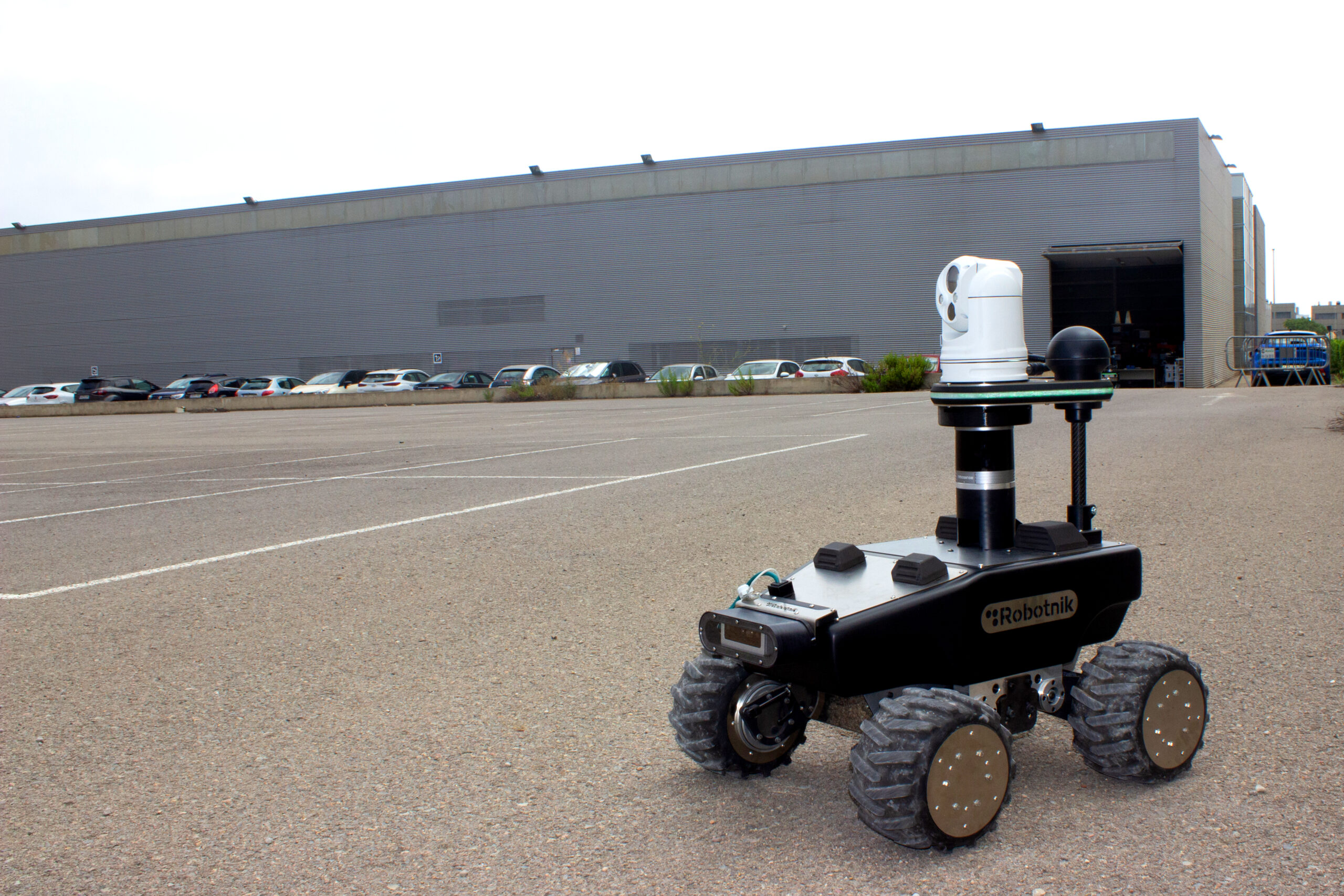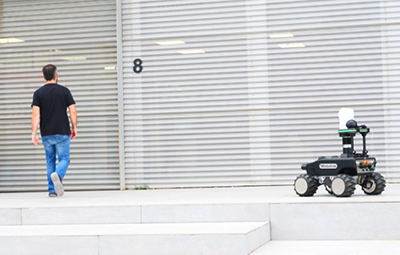Your next security guard is less than 1 m high and about 600 mm wide. It fits in any indoor or outdoor space, even the smallest or narrowest ones. It detects suspicious objects, abnormal temperatures, unusual activity, triggers alarms, collects data, processes information… and is capable by itself of patrolling large areas.
The new security guard will be a surveillance robot.
You can already find robots patrolling and guarding areas to improve security. This article details some of their benefits as well as examples of applications you may not be aware of.

WHAT IS A GUARD ROBOT?
A guard robot, also known as a surveillance robot, patrol robot or robotic security guard, is a machine designed for surveillance and protection purposes.
Depending on the security needs, valid solutions can be found to operate in indoor or outdoor environments or both. The models available on the market also differ in terms of size, sensorisation or functionalities. In this publication you can find detailed technical characteristics of a surveillance robot suitable for both indoor and outdoor use.
The key features of guard robots:
- Sensors: a patrol robot is equipped with a variety of specific sensors including cameras, thermal imaging devices, motion detectors or even microphones. These sensors allow them to monitor the environment and respond to potential hazards or incidents in their designated area.
- Mobility: One of the main advantages of robotic security guards over traditional security devices is mobility. Mobile robots replace the need for a large number of static devices to efficiently cover the area to be monitored.
- Connectivity: surveillance robots are often integrated into a networked security system to enable real-time communication with operators or central monitoring stations. Video streams and live data analysis enable fast and accurate decision making.
- Autonomous navigation: the development of an autonomous navigation system allows them to avoid obstacles and collisions, mapping or adapting to changing environments. This autonomy reduces the need for constant human intervention.
- Warning systems: triggering alarms, turning on lights or even the possibility of using warning devices such as acoustic signals are options that these robots can execute to address security gaps.
SECURITY ROBOTS VS. SECURITY GUARDS
Security procedures are changing and one of the key drivers are autonomous mobile robots as they bring new possibilities to the security and surveillance sector.
Despite some views, security personnel are still a necessary workforce. Their ability and intuition to evaluate and understand situations or to make discerning decisions are invaluable and should not be underestimated.
However, they have limitations such as fatigue, emotions and physical constraints, limits that do not apply to a robot guard.
Thus, a robotic security guard enhances the work of the human and exceeds its limits, making it a perfect tool to complement surveillance operations.
For example, the downtime of patrol robots is minimal as it does not need breaks, beyond the charging time. Therefore, it will perform more continuous and stable patrols.
Guard robots and human security guards represent two different approaches to ensure protection and surveillance. Both bring strengths to the table and their convergence is achieving new standards of protection and surveillance.

WHAT ARE THE APPLICATIONS OF ROBOT GUARDS?
The versatility of robotic security guards is extending their usability across a wide range of tasks. Here are some applications where these robots are having a significant impact:
- Industrial facilities: surveillance robots are increasingly being used in industrial environments for monitoring critical infrastructure, greatly improving safety. They can detect leaks, thermal overloads and trespassing in factories and power plants.
- Commercial spaces: Retailers and shops use surveillance robots to protect their premises, detect theft or vandalism, and this is one of the solutions provided by these robots in the retail sector.
- Construction sites: Construction sites are often vulnerable to theft and vandalism. Guard robots patrol these areas, monitoring for the presence of unauthorised personnel or equipment theft.
- Healthcare environments: Healthcare robotics are certainly the most widespread, but there is also an increase in the use of surveillance robots for hospitals and healthcare facilities to improve security in sensitive areas such as patient wards, hospitalisation areas and even pharmacies. They can also be a great help in complying with hygiene protocols, as demonstrated at Covid-19.
- Educational facilities: A surveillance robot is a potentially disruptive element in an educational environment, but they do a great job in protecting the safety of students and staff on school campuses and common facilities.
- Public spaces: although the legal framework is still vague regarding mobile robots in urban spaces and in most countries it is not yet regulated, their use offers a more complete and accurate monitoring of public areas such as parks and transport hubs than CCTV, being a determining factor in the reduction of criminal acts in public spaces.
In conclusion, robotic security guards are redefining perimeter security in various industries, positioning themselves as an integral solution to enhance surveillance and security protocols. Their precision, consistency and effectiveness in patrolling any size area, together with the advanced technology they incorporate, provides exceptional surveillance coverage.
If you need more info, contact with our team:

